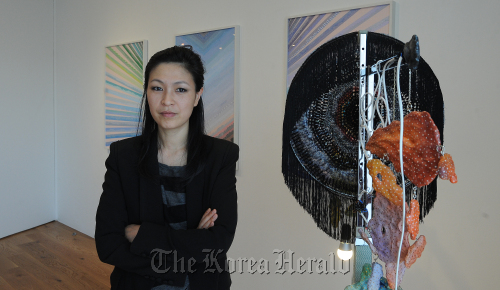Korean contemporary artist Yang Haegue blurs national and genre boundariesArtist Yang Haegue walked into the interview room in Kukje Gallery in Sogyeok-dong, central Seoul, looking chic as usual, donned in black from head to toe, including her signature black smoky eyes. After greeting the interviewer for a few seconds, her eyes quickly darted towards an artwork installed at a corner of the room.
“This is placed wrong. I never do it like this. You see how all the pressure is on this part? Something is wrong. You should check with the installation manual again,” she said crossly at an official at the gallery, readjusting an electric wire connected to her work.
Granted that she is an artist who just discovered her work incorrectly installed, it was soon understood that she was more than meticulous; she possessed a particular charisma which made people around her feel guilty when they fail to please her.
“I tend to nag a lot, even when working overseas,” Yang told The Korea Herald.
Yang is one of the most successful and internationally acclaimed South Korean contemporary artists. She uses a variety materials and media to express her sentiments about certain individuals, incidents or more generally about humanity, history and her private memories.

Yang Haegue poses with her work “Stone Dance ― Flat Black” on Wednesday at Kukje Gallery in Sogyeok-dong, central Seoul. (Lee Sang-sub/The Korea Herald)
She held many exhibitions overseas especially after she presented her works in the Korean Pavilion at the 2009 Venice Art Biennale. Her works are collected by major art museums such as Los Angeles County Museum of Art in L.A., Museum of Modern Art in New York and Carnegie Museum of Art in Pittsburg.
The latest addition to the prestigious list is Solomon R. Guggenheim Museum in New York, which bought Yang’s “Series of Vulnerable Arrangements ― Voice and Wind” last month. Composed of window blinds, fans and sprays, the work stimulates all five senses of the viewers and entices curiosity by filling the space with wind, fragrances and voices.
“It is a relief for an artist when a work is collected by a museum because it means that it will be well maintained and that it has secured a long life. I wish, though, that people will not only show interest in the fact that it is collected but also its history,“ said Yang.
The work was commissioned for the 53rd Venice Biennale and was exhibited again in 2010 at The New Museum in New York before finally being included in Guggenheim’s collection. It was challenging, she said, because everyone said that the work was very site-specific and New Museum’s white cube was totally different form the pavilion in Venice.
“I am happier because the work was collected after it was on show twice. I have experience and confidence that it can work in whatever exhibition the museum decides to showcase it in,” she said.
Born in Seoul in 1971, Yang graduated Seoul National University’s Fine Arts College and furthered her studies at Stadelschule in Frankfurt, Germany. She is currently based in both Berlin and Seoul. She, however, seemed rather offended to be considered a “Korean” artist paving her way in the world.
“I think I am anti-national. It is not just me; most progressive artists probably are, too. I imagine a different sense of solidarity and ponder on the concept of community. I believe that we can be directly or indirectly connected through art.
To cut the long story short, I am not interested. Rather, when they say things about me being a Korean artist, or being proud of me, I am embarrassed. I really have nothing to say when they mention my earning foreign currency or enhancing the national glory,” she said.
Art aficionados all over the world, anyhow, seem to find their own ways to sympathize with her works, regardless of whether they actually understand it or not. But people should at least study about it before simply asking questions, said Yang, because an artist cannot offer so much user-friendly information for everyone.
“I think an artist speaks a language other than the linguistic one. It can be one’s attitude or perspective on the world. It may differ depending on the individuals, but I think that very language is the most important one for an artist. I do communicate, but rather in one-way. I don’t target anyone. I am not that nice.”
The symposium “Echo” which will be held on Nov. 25 at Artsonje Center in central Seoul, will be a rare opportunity for experts including Yang to profoundly discuss her works so far, including the production of a monodrama “The Malady of Death” in 2009, based on French writer Marguerite Duras’ short novel; the publication of the book “Melancholy is a Longing for the Absoluteness” in 2009; and her solo exhibition “Voice over Three” at Artsonje Center in 2010.
“Too many things are done, forgotten, and spent in vain. It (the symposium) will be a moment for those who have seen my show and those who haven’t to get together again. I hope people will realize that I am not a chic person but a persistent one,” said Yang.
By Park Min-young (claire@heraldcorp.com)

![[AtoZ into Korean mind] Humor in Korea: Navigating the line between what's funny and not](http://res.heraldm.com/phpwas/restmb_idxmake.php?idx=645&simg=/content/image/2024/04/22/20240422050642_0.jpg&u=)
![[Exclusive] Korean military set to ban iPhones over 'security' concerns](http://res.heraldm.com/phpwas/restmb_idxmake.php?idx=645&simg=/content/image/2024/04/23/20240423050599_0.jpg&u=20240423183955)


![[Herald Interview] Why Toss invited hackers to penetrate its system](http://res.heraldm.com/phpwas/restmb_idxmake.php?idx=645&simg=/content/image/2024/04/22/20240422050569_0.jpg&u=20240422150649)
![[Graphic News] 77% of young Koreans still financially dependent](http://res.heraldm.com/phpwas/restmb_idxmake.php?idx=645&simg=/content/image/2024/04/22/20240422050762_0.gif&u=)